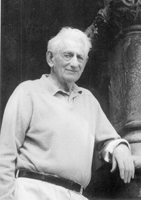SIAM Announces New Web Site: History of Numerical Analysis and Scientific Computing
July 6, 2006

SIAM News reviewer/essayist Philip Davis has conducted many of the interviews that make up a large part of SIAM�s history project. His interviews �reflect his close association with the topic and the period,� says SIAM technical director Bill Kolata.
Over the past few years, SIAM has been tracking down and interviewing people who played key roles in the development of numerical analysis and scientific computing, from World War II through much of the 1980s. The goal was to preserve information about the people, the challenges they faced, and the impact of the evolving field on applications. The project was supported by a grant from the U.S. Department of Energy.
Within the long and rich history of numerical analysis, "modern" numerical analysis---the focus of this project---is characterized by the synergy of the programmable electronic computer, mathematical modeling, and the opportunity and need to solve large and complex problems in application areas. One of the motivations for the project was to create a complement to the extensive history of the development of computers, documenting the equally important development of algorithms, mathematical models, and software.
SIAM has made the results of the project available on the Web (http://history.siam.org). Materials posted include transcripts of oral histories based on interviews conducted during the grant period (see samples below), links to relevant oral histories on other sites, and historical articles by people who are or were intimately engaged in the development of numerical analysis and computing.
The interviews were conducted primarily by two individuals. One, well known to readers of SIAM News and himself a participant in the history, is Philip Davis of the Division of Applied Mathematics at Brown University. The other, Thomas Haigh, is a historian of science and computing in the School of Information Studies, University of Wisconsin�Milwaukee. Davis's interviews range widely and reflect his close association with the topic and the period. Haigh's focus was on prominent developers of mathematical software. Among others who conducted occasional interviews for the project are Philip Colella, an applied mathematician and computational scientist at Lawrence Berkeley National Laboratory, and Ulf Hashagen, a historian from the Deutsches Museum in Munich. William Aspray of the School of Informatics, Indiana University, a science historian and biographer of John von Neumann, chaired the project's oversight committee.
Although the grant has ended, work on the project continues. One of the lessons learned in the course of the project is that it takes much longer than expected to conduct interviews, produce and edit transcripts, and obtain approval from interviewees. As a result, additional interviews are in the pipeline. Supplementary material, including photos and related documents (e.g., material from the SHARE library) will be added as it becomes available.
Comments and suggestions from readers are welcome (to [email protected]).
---Bill Kolata, SIAM Technical Director.

